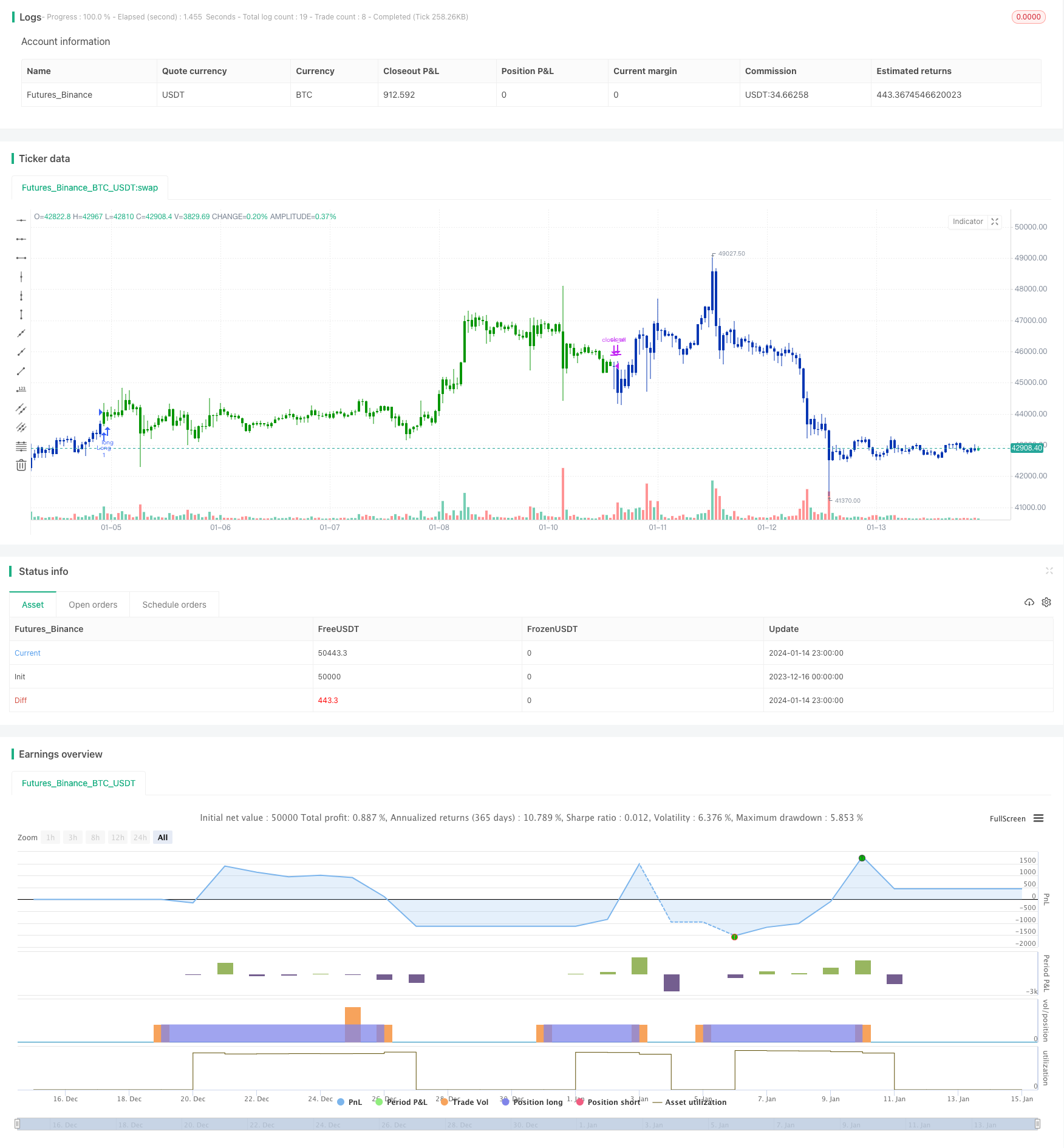
概述
本策略是将123形态回转策略和枢轴点策略进行组合,以期获得更高的胜率。其中123形态回转策略判断趋势反转点,而枢轴点策略确定关键支持与阻力位。两者结合,既可以捕捉趋势,又可以确定具体的入场与出场价格。
策略原理
123形态回转策略
该策略基于随机指标判断趋势反转点。具体原理是: 当收盘价连续2天低于之前收盘价,并且9日慢速STO指标低于50时,做多;当收盘价连续2天高于之前收盘价,并且9日快速STO指标高于50时,做空。
枢轴点策略
该策略根据前一天的最高价、最低价与收盘价计算出3条支撑线与3条阻力线。具体计算方法为:
中枢点=(最高+最低+收盘)/3
支撑1=2*中枢点-最高
阻力1=2中枢点-最低
支撑2=中枢点-(阻力1-支撑1)
阻力2=中枢点+(阻力1-支撑1)
支撑3=最低-2(最高-中枢点)
阻力3=最高+2*(中枢点-最低)
并根据支撑与阻力位判断入场与出场。
策略优势
- 结合两种不同类型策略的优点,既可以判断趋势反转,又可以锁定具体价格位,胜率较高
- 123形态策略可以有效判断短期内趋势反转点
- 枢轴点策略可以利用关键支撑阻力位过滤假突破
风险与对冲
- 双随机指标存在一定滞后,可能错过短线反转
- 枢轴点并非百分之百有效,可能出现突破继续运行
- 可以适当调整参数,或与其他指标组合使用来对冲风险
策略优化方向
- 可以测试不同参数对策略效果的影响
- 可以尝试与其他指标或形态组合,提高策略效果
- 可以结合机器学习算法动态优化参数
总结
本策略巧妙地将趋势判断与关键价格位结合,既可判断趋势反转点,又可利用支撑阻力过滤信号。通过参数与策略组合优化,可以进一步提升效果。该策略值得量化交易者进一步研究与应用。
策略源码
/*backtest
start: 2023-12-16 00:00:00
end: 2024-01-15 00:00:00
period: 1h
basePeriod: 15m
exchanges: [{"eid":"Futures_Binance","currency":"BTC_USDT"}]
*/
//@version=4
////////////////////////////////////////////////////////////
// Copyright by HPotter v1.0 21/04/2021
// This is combo strategies for get a cumulative signal.
//
// First strategy
// This System was created from the Book "How I Tripled My Money In The
// Futures Market" by Ulf Jensen, Page 183. This is reverse type of strategies.
// The strategy buys at market, if close price is higher than the previous close
// during 2 days and the meaning of 9-days Stochastic Slow Oscillator is lower than 50.
// The strategy sells at market, if close price is lower than the previous close price
// during 2 days and the meaning of 9-days Stochastic Fast Oscillator is higher than 50.
//
// Second strategy
// Pivot points simply took the high, low, and closing price from the previous period and
// divided by 3 to find the pivot. From this pivot, traders would then base their
// calculations for three support, and three resistance levels. The calculation for the most
// basic flavor of pivot points, known as ‘floor-trader pivots’, along with their support and
// resistance levels.
//
// WARNING:
// - For purpose educate only
// - This script to change bars colors.
////////////////////////////////////////////////////////////
Reversal123(Length, KSmoothing, DLength, Level) =>
vFast = sma(stoch(close, high, low, Length), KSmoothing)
vSlow = sma(vFast, DLength)
pos = 0.0
pos := iff(close[2] < close[1] and close > close[1] and vFast < vSlow and vFast > Level, 1,
iff(close[2] > close[1] and close < close[1] and vFast > vSlow and vFast < Level, -1, nz(pos[1], 0)))
pos
PP2(res,SellFrom,BuyFrom) =>
pos = 0.0
xHigh = security(syminfo.tickerid,res, high)
xLow = security(syminfo.tickerid,res, low)
xClose = security(syminfo.tickerid,res, close)
vPP = (xHigh+xLow+xClose) / 3
vS1 = 2*vPP - xHigh
vR1 = 2*vPP-xLow
vS2 = vPP - (vR1 - vS1)
vR2 = vPP + (vR1 - vS1)
vS3 = xLow - 2 * (xHigh - vPP)
vR3 = xHigh + 2 * (vPP - xLow)
S = iff(BuyFrom == "S1", vS1,
iff(BuyFrom == "S2", vS2,
iff(BuyFrom == "S3", vS3,0)))
B = iff(SellFrom == "R1", vR1,
iff(SellFrom == "R2", vR2,
iff(SellFrom == "R3", vR3,0)))
pos := iff(close > B, 1,
iff(close < S, -1, nz(pos[1], 0)))
pos
strategy(title="Combo Backtest 123 Reversal & Pivot Point V2)", shorttitle="Combo", overlay = true)
line1 = input(true, "---- 123 Reversal ----")
Length = input(14, minval=1)
KSmoothing = input(1, minval=1)
DLength = input(3, minval=1)
Level = input(50, minval=1)
//-------------------------
line2 = input(true, "---- Pivot Point V2 ----")
res = input(title="Resolution", type=input.resolution, defval="D")
SellFrom = input(title="Sell from ", defval="R1", options=["R1", "R2", "R3"])
BuyFrom = input(title="Buy from ", defval="S1", options=["S1", "S2", "S3"])
reverse = input(false, title="Trade reverse")
posReversal123 = Reversal123(Length, KSmoothing, DLength, Level)
posPP2 = PP2(res,SellFrom,BuyFrom)
pos = iff(posReversal123 == 1 and posPP2 == 1 , 1,
iff(posReversal123 == -1 and posPP2 == -1, -1, 0))
possig = iff(reverse and pos == 1, -1,
iff(reverse and pos == -1 , 1, pos))
if (possig == 1 )
strategy.entry("Long", strategy.long)
if (possig == -1 )
strategy.entry("Short", strategy.short)
if (possig == 0)
strategy.close_all()
barcolor(possig == -1 ? #b50404: possig == 1 ? #079605 : #0536b3 )